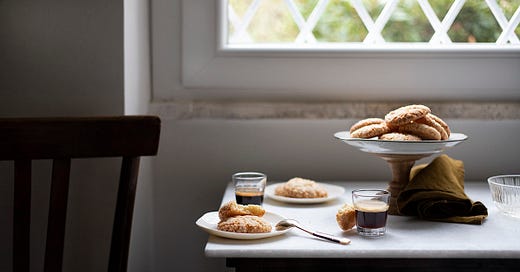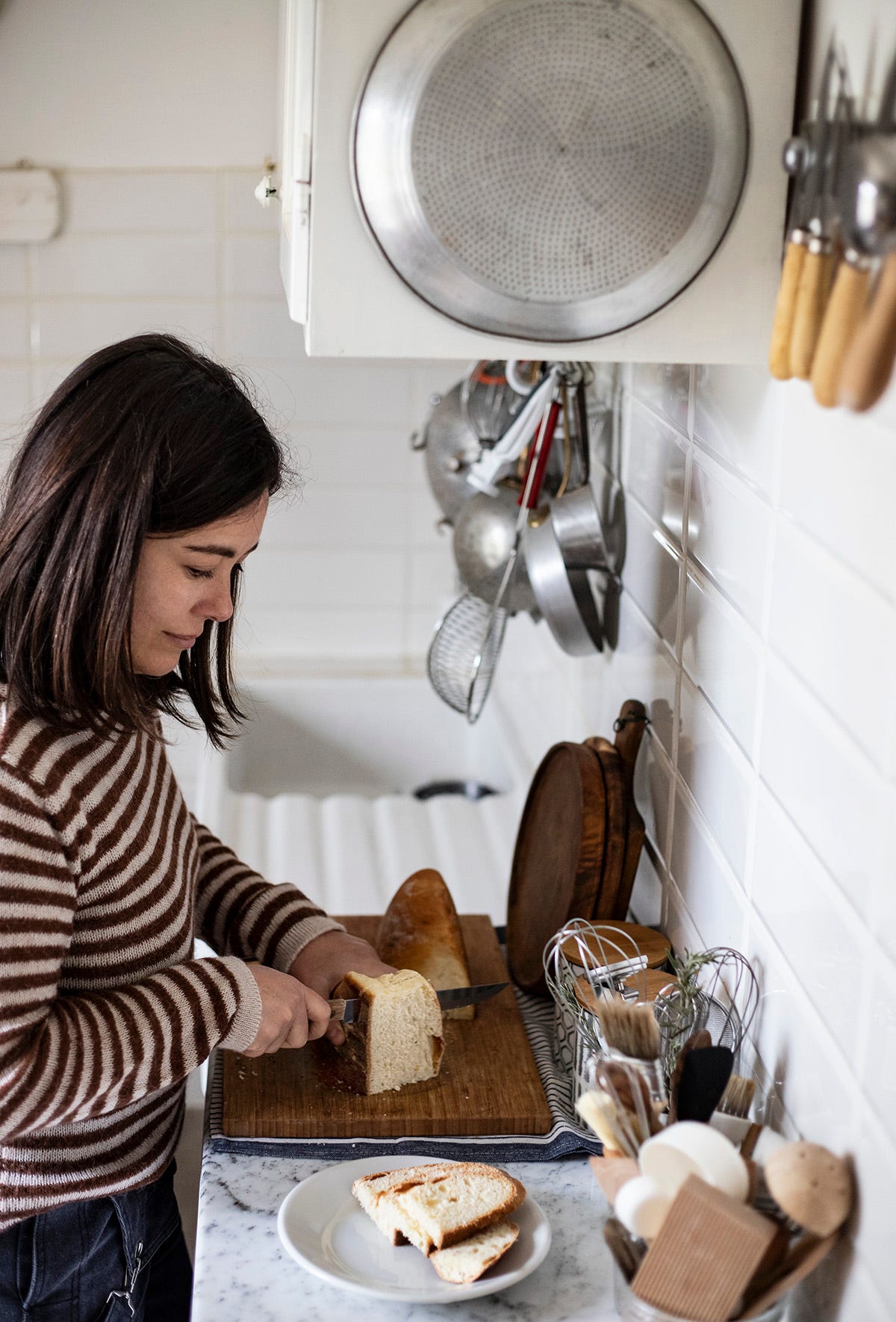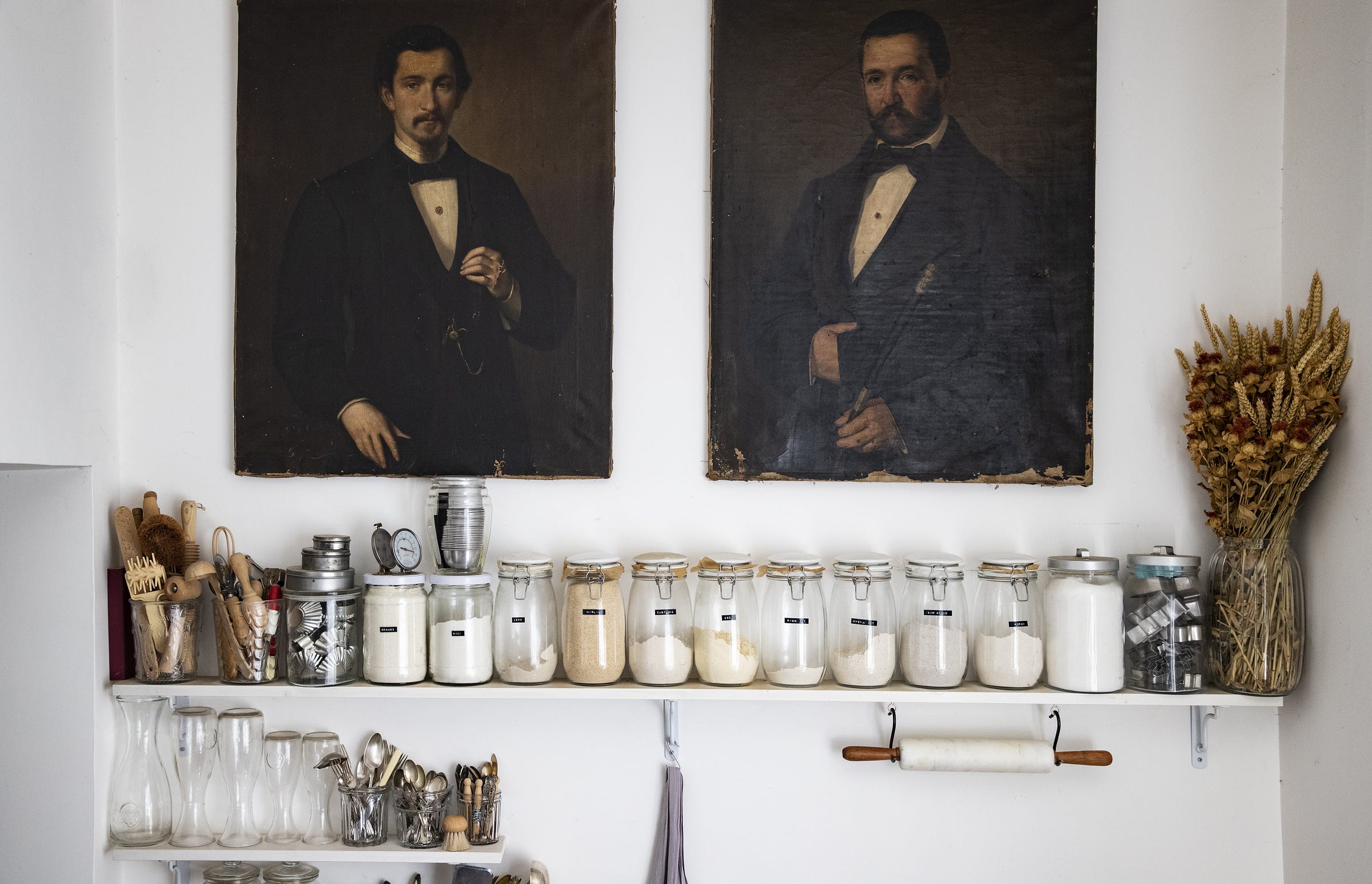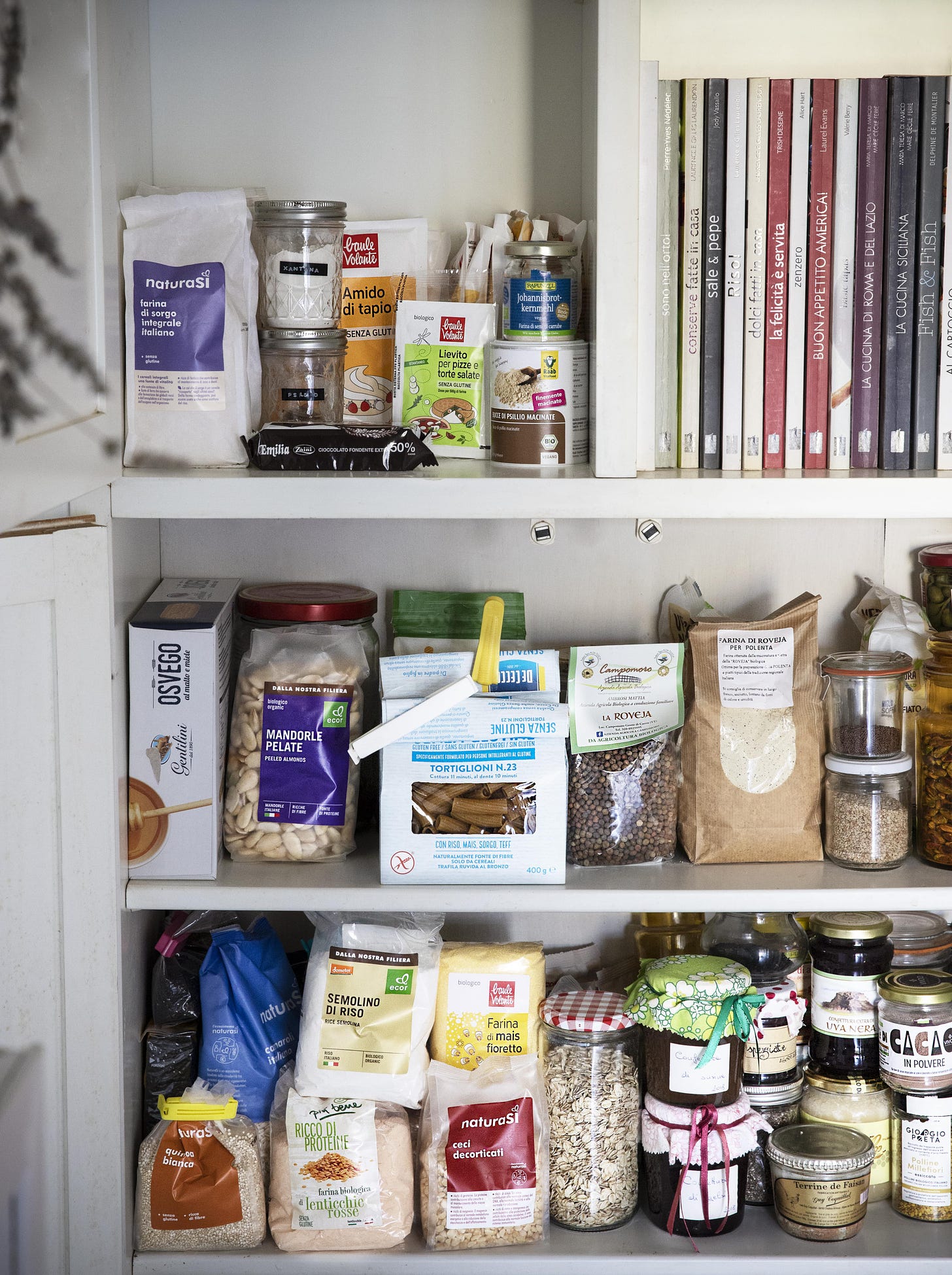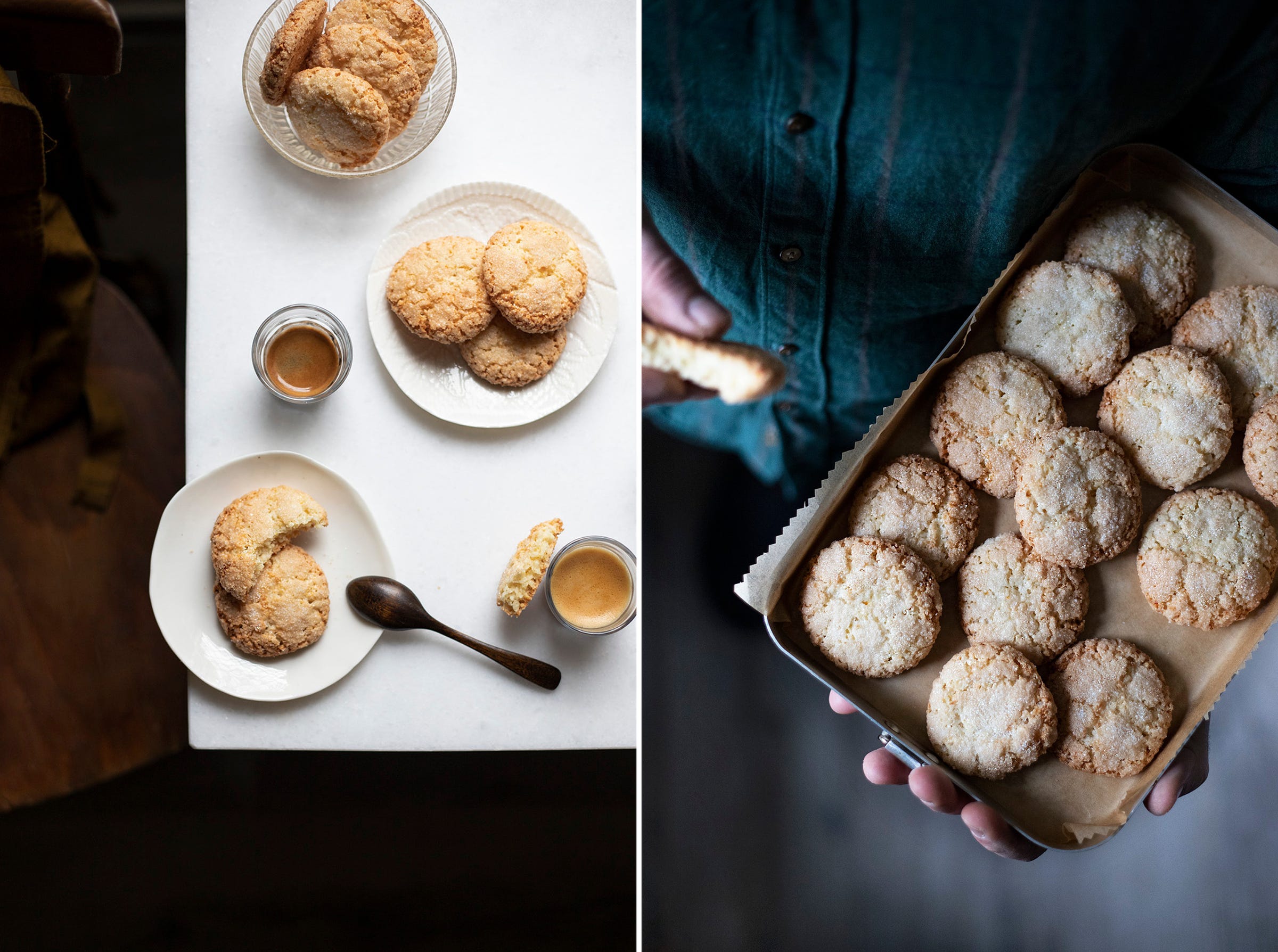Q&A with Laura Ottaviantonio. Other people's pantries
Laura Ottaviantonio, her recipes and stories between Abruzzo, Rome and the countryside | A gluten-free, inclusive pantry | Abruzzo amaretti cookies
Other people’s pantries is a series of Q&A with a focus on pantries as a privileged way to get into people’s lives, cooking styles, and favourite recipes. It is also an opportunity to chat with professionals I admire, and with friends with whom I have shared an important part of my personal and professional growth. You can read all the previous interviews here.
Today we have a chat with Laura Ottaviantonio, high school teacher in Rome, food blogger and photographer, with a unique and unmistakable voice in the Italian food writing scene. [I tried to preserve her unique style in translating her interview]
We met years ago through our blogs, we shared chats, confidences, dinners in Rome and days in the kitchen here at my place. I love the way she recounts and photographs her life in the countryside, with her pets, her vegetable garden, her passion for camper van trips, classic cars, and gluten-free cooking. It is this gluten-free adventure, which began a few years ago, that brings out Laura's indomitable, creative and rebellious spirit. She hasn’t surrendered to her new without condition, on the contrary, she has turned it into a daily challenge, a search for the perfect new recipe.
Today we chatted about inclusive ingredients and pantries, with a look at what it meant for her to explore the gluten-free world.
Follow Laura on Instagram: @ricetteevicende and on her websites, where she shares her recipes and stories (in Italian): www.ricetteevicende.com
Part of our conversation is paywalled, and the subscribers will find Laura’s recipe for her amaretti, typical cookies coming from Abruzzo that are naturally gluten-free, two aspects that well represent her cuisine and approach to food.
When you join our subscription-based newsletter, you are actively contributing to the making of Letters from Tuscany.
Ciao Laura, can you briefly introduce yourself?
My name is Laura and I am an Italian, Latin, and history teacher in a Roman high school. When I am not correcting homework, and in the rare free time, I write, cook and photograph, all about food.
What is your relationship with the pantry? and what has been the role of the pantry in your family?
When I approached the kitchen in a conscious and passionate way, I immediately felt the attraction for a pantry room, a kind of wardrobe room in which to sit and admire one's favourite collection, which in my specific case was not clothes but preserves, jams, dried fruits, flours and oils, honeys and everything that could, in its pre-established order, instill in me a certain serenity that I would never starve.
Tell us a little about what changed in your life when you discovered you had to go ‘gluten-free'?
When, three years ago, I discovered that the debilitating reason for my frequent migraines was all down to a very high intolerance to wheat, my pantry and I inevitably had to change.
The idea of feeding myself mostly with pre-packaged, dedicated, gluten-free diversity food, often a result of industrial mixes, did not appeal to me: in that very idea there was a principle of exclusion not only aimed at my favourite food (pasta, bread, biscuits, sweets of any kind) but also at the very act of cooking.
What is your approach to gluten-free and how does it reflect on your pantry?
Avoiding an avoidance diet was the first goal: allowed food/not allowed food are expressions I don’t like. The specific vocabulary in these cases reveals itself: it is dividing, very fundamentalist, politically incorrect.
I discovered that the search for 'normality', albeit within my 'particularity', could become viable in the kitchen as long as I did not give in to pre-cooked shortcuts or hodgepodge of unidentified miracles.
In short, the aim was initially to look for an 'ad personam' solution, a strategy to look ahead in my own way and for all those like me: 'intolerant' to intolerance rather than to gluten. "Will there be pioneers around or am I the only rebel?" - I have asked myself several times.
And indeed, it was only by becoming familiar with this world and soon feeling part of it that I was able to redraw the index of priorities among the foods in my larder: naturally gluten-free flours, cereals and legumes became the undisputed protagonists, along with many natural thickening or gelling agents such as carob bean gum and psyllium husk powder, all characterised by very important regulatory principles for the well-being of the intestine.
If you had to describe your pantry in one word, what would it be?
If I had to describe my cooking today with an adjective, I would say for obvious reasons that it is 'inclusive'. When I cook for friends and family, there is no longer any need to specify whether my menu is gluten-free or gluten-containing. Saying that it is for everyone is more appealing to me and the confirmation always comes along with the bread basket: 'as good as the 'normal' one' - someone occasionally tells me.
How many stories are there in your pantry?
The stories that populate my pantry are many, all traceable to those of a 'family epic', an inexhaustible source of inspiration every time I find myself thinking about a recipe: one of the reasons why in the personal narrative of my food blog at some point I became 'Ricetteevicende' (recipes and stories).
You are from Abruzzo, you lived in Rome, and now you and your husband Marco have moved to the countryside. Does your pantry reflect your movements?
Abruzzese origins, city life and then country life are present in my pantry through three ingredients that cannot be missed: pasta, of which my Abruzzo has always been a great producer; sour cherries in syrup, which in Rome are indispensable in the ricotta tart; preserves in oil, which are the most evident result of the new country life struggling with a vegetable garden and a small greenhouse/seedbed that have been filling us with great satisfaction for a few years now.
What is the one ingredient that just cannot be missing from your ideal pantry?
The dried sweet pepper is the ingredient, the flavour that cannot be missing from my sauces. It is the Altino pepper, an Abruzzi speciality that makes the fish soups of much of Abruzzi's seafood cuisine sweet.
When I return to my homeland, I buy large quantities of this sweet, dried pepper, already ground: it is excellent to add flavour to the corn pizza we serve with orapi (wild spinach), or to colour the dough of homemade breads and pastries.
What are the most important and relevant ingredients of your gluten-free cuisine? And of Abruzzo cuisine?
Another key ingredient in my gluten-free cuisine is brown rice: it is a trivial ingredient if one looks at it from a gluten-centric viewpoint, but no, it is quite the opposite. I stock up on brown rice and I make flour with it with a home mill, something that helped me lower the high costs of gluten-free flours. Above all, brown rice flour is the basis for the newfound pleasure of home baking: it is the flour with which I created my gluten-free sourdough starter.
Speaking of the Abruzzo cuisine, another fundamental ingredient is cooked must: it soaks the fillings of our cakes and the surfaces of the Easter aniseed breads. For me, it is also the secret ingredient in the filling of caggionetti, stuffed fried sweet ravioli.
What is your favourite recipe to make with pantry ingredients?
When I think of a quintessential pantry recipe I think of a cake: the thing I missed most in the transition period from the discovery of my necessity to go gluten-free until a few years ago. Whatever cake I made at the beginning was hard chew, and above all it had the unpleasant sensation of a mouthful of wet sand.
Working on regaining a feeling of softness and elasticity was a great achievement, especially since in this case no special remedy was required other than the use of carob bean gum flour: the most successful gluten effect of my experiments.
Do you have a life-long dream hidden somewhere in your pantry?
When I think about my newfound relationship with my pantry, I dream of writing a book. Gluten-free cookbooks haven’t been very useful so far, as I just stumbled upon to 'naturally gluten-free' profiles who are mostly authors who compensate for the lack of gluten with exaggerated fat and eggs.
I would instead like to write and tell the story of 'gluten-free' food for what it is: a healthy food that should actually be part of everyone's table to compensate for the omnipresence of gluten everywhere.
Last question! Can you share a sweet recipe to make with pantry ingredients?
The recipe I wish to share comes from the pantry and goes back to the pantry for storage, although in our house it usually skips this stage due to our sweet tooth.
These typical cookies coming from Abruzzo that are naturally gluten-free well represent my cuisine and approach to food.
Amaretti abruzzesi are the bridal sweets along with mostaccioli, spumetti and torroncini. The truth is that they are traditionally served at any festivity and are one of the many ways to make use of the ever-present almonds that are never lacking in an Abruzzese pantry, as well as being gluten-free.

